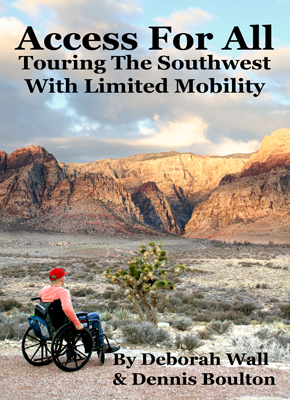
Access for All is a diligently documented and vibrantly depicted travel guide for tourists with limited mobility, providing hundreds of detailed descriptions of the accessible trails, overlooks, campgrounds, parking, bathrooms and lodging accommodations for the Southwest’s most breathtaking and beautiful natural sites. Destinations abound throughout Arizona, Utah, Nevada, and western California.
This book is an essential reference for travelers with some difficulty in moving from place to place, but who still wish to visit the most stunning scenic outdoor attractions in four southwestern states. Directions, with measured driving distances and walking distances, enable visitors to choose those sites that best suit their needs. From the Grand Canyon to Death Valley, from old-time locomotive tours to scenic drives and dozens of historical (and prehistoric) sites, each entry focuses upon the degree of access available for those with limitations on their mobility. Parks and campgrounds with suitable accommodations are listed and the question of whether restrooms and hotel rooms are accessible is always answered. The book also indicates whether walkways to viewpoints are suitable for wheelchairs or walkers, as well as whether there are benches or other resting places along the way.
Deborah Wall and Dennis Boulton, outdoor writers and photographers, focus their work on the southwestern United States. They wrote the popular “Accessible Recreation” column for the Prime View newspaper in Las Vegas, Nevada. Deborah continues to write the bi weekly “Outdoor Recreation Column” in the View Newspapers, which she has done since 2005. The pair has logged tens of thousands of miles in the region seeking out the most interesting and scenic destinations for those who may have limited mobility. They have personally visited, carefully documented, and beautifully photographed every destination in this book.
“Unfortunately many people with limited mobility, either because of advanced age or disability, can be hesitant to explore parks and other remote places because they don’t know if there will be accommodations in the form of flat, paved paths, accessible restrooms and appropriate parking. That’s why Boulton and Wall teamed up to write Access For All: Touring the Southwest with Limited Mobility….”
[Excerpt]
Death Valley National Park
Despite its sinister name, Death Valley is probably on more “bucket lists” of must-go-there-once destinations than any other place west of the Grand Canyon. There is a satisfaction in knowing you have been to the lowest point in the United States, and the hottest, and the driest. Conditions so famously bad everybody wants to experience them! Yet these negatives are found in remarkably beautiful surroundings. Because few large plants are able to thrive here, the mountains and salt flats lie naked. You can see the tracks of the geologic forces that wrought this twisted landscape, and the color palette in which they worked. Nobody should miss it, and nobody has to, because the most striking sights are easily accessible to all.
Death Valley won its name for imposing near-death experiences on a group of pioneers who tried to cross it with wagons during the California Gold Rush. Later prospectors explored for gold and mostly found borax, which was mined here commercially for years. Railroad trains even chugged through the valley for a few decades to serve its mines and those of Central Nevada. But the region’s real treasure was its uniquely unspoiled appearance, which was recognized and protected in 1933 as a national monument. In 1994 Death Valley gained national park status, and now contains 3.4 million acres. Most of that is in southeastern California with one small section in Nevada, known as the Death Valley Triangle.
The park is known for its severe summer heat and dry climate. Although normal daytime summer high temper-atures average about 115 Fahrenheit, temperatures in the valley’s lowlands can exceed 130.
In fact, the World Meteorological Organization (WMO) has officially announced that Death Valley holds the record for the world’s hottest surface temperature of 134 degrees Fahrenheit. This temperature was recorded on July 10, 1913 at Furnace Creek Ranch. Both of the authors per-sonally saw the Furnace Creek thermometer at 131 degrees in July 2012. Winter temperatures have gone as low as fifteen degrees Fahrenheit although they average thirty-nine.
[Excerpt]
Location: In Death Valley National Park, about 120 miles from Las Vegas.
Directions: From Las Vegas, take I-15 south to Nevada 160. Drive about 53 miles west to Pahrump. Turn left onto Bell Vista Road and drive 27 miles to Death Valley Junction. Go right and then take an immediate left to California 190 west for about 29 miles to Furnace Creek.
and at www.longstreetcasino.com. Pahrump, Nevada, www.pahrumpnv.org, as well as Beatty, Nevada, www.beattynevada.org, each offer a few choices.
……………
